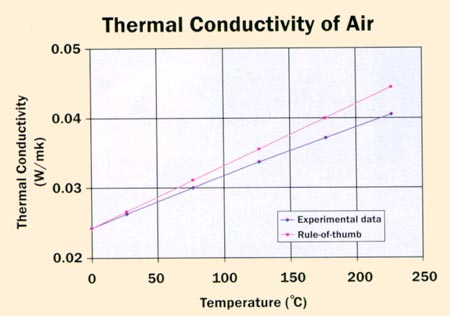In the Technical Data column of ElectronicsCooling Magazine, September 1998, the thermal conductivity of gases in general has been discussed. A few sentences were devoted to the temperature and pressure dependence of the most common gases. For example, it was stated that above 0.001 bar, the increase in thermal conductivity is of the order of magnitude of 1% per bar increase of pressure. From these figures, it can be concluded that changes in thermal conductivity due to atmospheric variations can be neglected in most cases. Also, it was noted that the thermal conductivity at atmospheric pressure is almost proportional to the absolute temperature. Let us check the correctness of this rule-of-thumb.
The graph plots experimental data (Eckert & Drake, 1972) and the relationship k = k0/T0*T, with k the thermal conductivity, k0 and T0 chosen at 0�C and T the absolute temperature. The error at 100�C is about 5%, which can be reduced by choosing a different reference point. Because most analyses are performed at operating temperature, it is recommended to use the experimental value at 100�C as the reference point.
In most handbooks, only the value at room temperature is quoted. However, as is obvious from the graph, by using this value at 100�C the error becomes rather large, about 30%. Needless to say, this error does not only affect the correctness of conduction heat transfer analysis through thin air layers, but also of the Nusselt number from which the heat transfer coefficient is calculated.
 |





